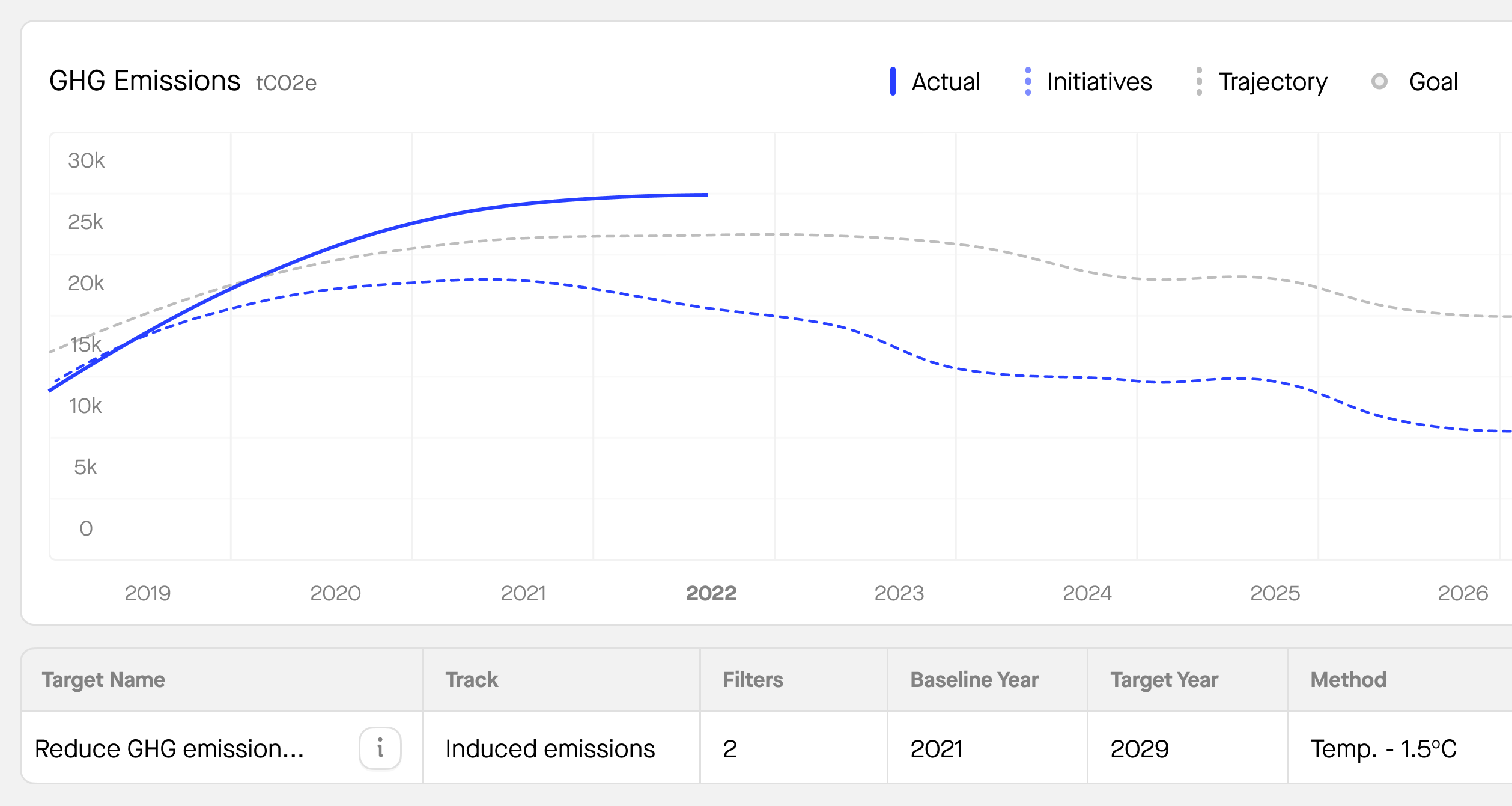We outline the differences between these two key methods of target setting and show you how to overcome the key challenges of implementing intensity-based targets.
Emissions reduction targets are the cornerstone of any credible sustainability plan. They define a company’s commitment to reducing GHG emissions, which are the primary drivers of climate change. To appreciate the nuances of absolute and intensity-based targets, let’s explore each in detail.
Absolute emission reduction targets
Absolute emissions reduction targets are straightforward and explicit. They focus on decreasing a company’s total GHG emissions by a set quantity within a defined timeframe. For example, a company might set an absolute emissions target, pledging to cut emissions by 35% by 2025 or achieve “Net Zero” emissions by a specific year. These targets are often seen as direct contributions to global climate goals.
Benefits of absolute targets
Policymakers and environmental organizations often favor absolute emissions reduction targets, primarily because they align with the broader imperative of reducing total GHG emissions. For instance, the Paris Agreement commits countries worldwide to reduce their emissions collectively, with the aim of limiting global warming to well below 2 degrees Celsius above pre-industrial levels.
Challenges of absolute targets
While these absolute reduction targets are laudable for their environmental ambition, they can sometimes be overly uniform in their application. Every company operates within unique circumstances, and their capacity to reduce emissions can vary significantly. Factors such as sector, industry, and the complexity of supply chains influence the cost and feasibility of emissions reductions. This discrepancy can lead to difficulties in setting realistic, attainable targets for all companies.
Intensity-based emissions targets
Intensity-based emissions targets offer a different perspective. These targets measure a company’s emissions of greenhouse gases in relation to a physical or economic metric, allowing businesses to establish emissions reduction objectives while factoring in growth. For example, a manufacturing company may commit to reducing its carbon emissions by 50 kilograms of CO2 equivalent per metric ton of product output annually.
Benefits of intensity targets
Intensity-based emissions targets are dynamic and adaptable. They account for variations in business activities, such as mergers, acquisitions, and sales growth, which can significantly affect emissions. These targets provide a framework that evolves with the company’s changing circumstances, eliminating the need to reset objectives constantly.
Challenges of intensity targets
While intensity-based targets have their merits, they don’t ensure absolute emissions reductions. In some cases, they allow emissions to increase as a business expands, albeit at a slower rate than if no action were taken. Critics argue that if a company’s emissions intensity decreases while production volume increases significantly, the overall carbon footprint may still grow.
The role of intensity metrics
Intensity metrics play a vital role in emissions management. These metrics quantify greenhouse gas emissions per unit of activity, energy system or output, providing a normalized view of emissions across different industries and activities. For example, metrics like CO2 emissions per unit of energy produced (CO2e/kWh) or methane emissions per head of cattle (CH4/head) help compare emissions performance.
Why intensity metrics matter
Intensity metrics are valuable because they offer a holistic view of emissions intensity and efficiency. They express the carbon intensity of a particular process or industry, helping to normalize emissions due to changes in organizational activity. In essence, intensity metrics provide clarity regarding the impact of specific actions.
Let’s unpack that with an example: Suppose a company increases its workforce, causing total emissions to rise. However, the introduction of an employee commuting benefit reduces emissions per full-time employee. In this scenario, carbon intensity metrics highlight the positive impact of the commuting program, even though absolute emissions increased. This granularity allows companies to assess the effectiveness of their sustainability initiatives more accurately.
The case for intensity-based targets
While both absolute and intensity-based emissions targets have their place in sustainability strategies, the case for intensity-based targets is compelling. Here’s why they are emerging as an important way to set targets and track progress for many companies committed to sustainability:
1. Flexibility and adaptability
Intensity-based targets offer a dynamic approach that adapts to changing business circumstances and economic growth. Companies often undergo transformations, such as mergers, acquisitions, or shifts in market demand. These changes can significantly impact emissions, making it challenging to adhere to rigid absolute targets. Intensity-based targets provide room for growth while still emphasizing emissions efficiency.
2. Reflecting real-world business
In the dynamic business landscape, growth is often a key objective. Intensity-based targets recognize that emissions reductions should not hinder growth but rather complement it. By linking emissions to economic output, companies can set targets that align with their operational realities. This approach ensures that sustainability goals remain achievable and realistic, even as the business expands.
3. Encouraging efficiency
Intensity-based targets inherently encourage efficiency improvements. Companies are incentivized to seek innovative ways to produce more with fewer emissions, driving technological advancements and sustainable practices. This focus on efficiency contributes to long-term sustainability and can lead to innovative solutions with broader environmental benefits.
4. Managing supply chain complexity
For many companies, a significant portion of their emissions comes from the supply chain. Intensity-based targets offer a practical way to navigate this complexity. They allow businesses to measure emissions efficiency across the entire value chain, fostering collaboration and sustainability improvements with suppliers and partners.
5. Supporting transparency and reporting
Transparency is a hallmark of modern business. Stakeholders, including investors, customers, and regulators, are increasingly interested in understanding a company’s environmental impact. Intensity-based targets provide a clear and understandable metric for reporting progress, making it easier for companies to communicate their sustainability efforts effectively.
Absolute or intensity targets?
In the pursuit of sustainability, companies face the delicate task of setting a meaningful emission reduction target. While absolute targets align with global climate objectives, they may not always reflect the complexities of individual businesses. Intensity-based targets offer a flexible alternative that considers growth and operational realities, fostering sustainability without compromising expansion. However, there is also an element of rigidity. For instance, the Science Based Targets initiative (SBTi) indicates: “An intensity target should only be set if it leads to absolute reductions in line with climate science or is modeled using a sector-specific decarbonization pathway that assures emissions reductions for the sector.”
In reality, it’s useful to set both absolute and intensity targets simultaneously.
Example:
A car manufacturer commits to reduce absolute scope 1 and 2 GHG emissions by 50.4% by 2030 from a 2018 base year.
The same company further commits to reduce scope 3 GHG emissions from the use of sold products of light-duty vehicles by 30% per vehicle km by 2030 from a 2018 base year.
This means that, if in 2018 their intensity was 0.1 tCO2e/vehicle.km, they commit to reaching an intensity of 0.07 tCO2e/vehicle.km by 2030.




